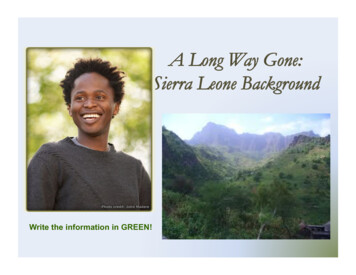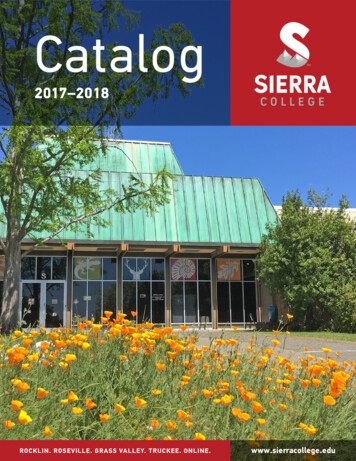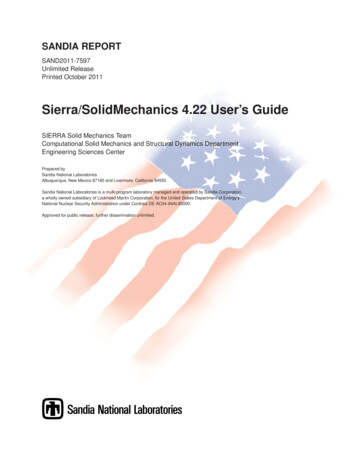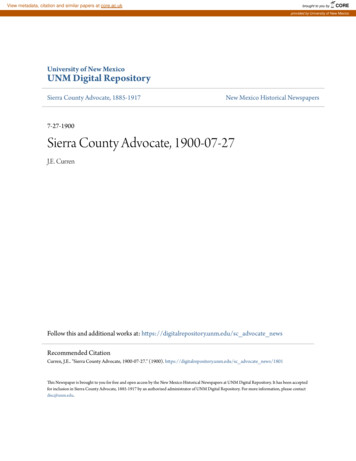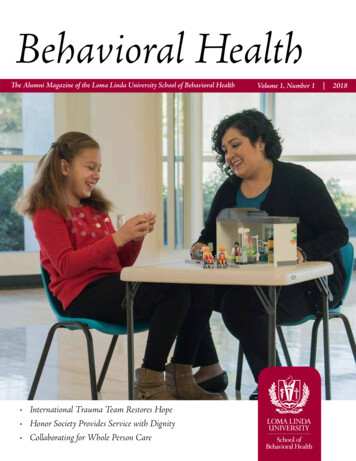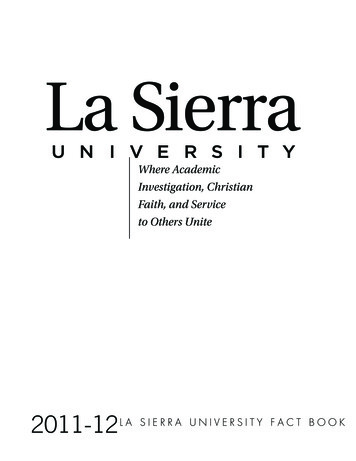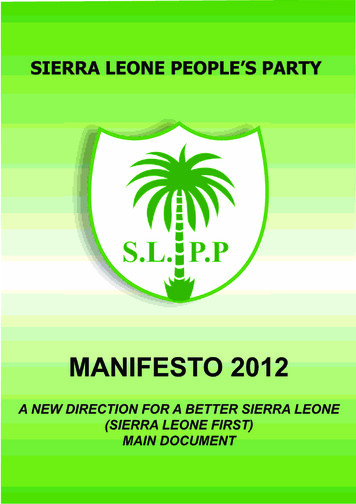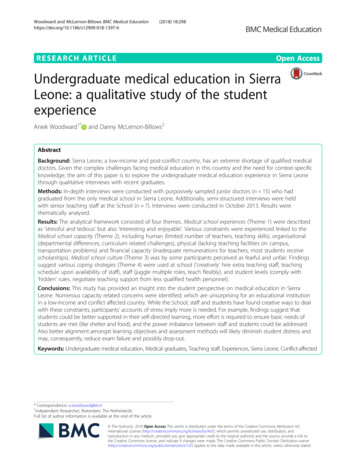
Transcription
Woodward and McLernon-Billows BMC Medical (2018) 18:298RESEARCH ARTICLEOpen AccessUndergraduate medical education in SierraLeone: a qualitative study of the studentexperienceAniek Woodward1*and Danny McLernon-Billows2AbstractBackground: Sierra Leone, a low-income and post-conflict country, has an extreme shortage of qualified medicaldoctors. Given the complex challenges facing medical education in this country and the need for context-specificknowledge, the aim of this paper is to explore the undergraduate medical education experience in Sierra Leonethrough qualitative interviews with recent graduates.Methods: In-depth interviews were conducted with purposively sampled junior doctors (n 15) who hadgraduated from the only medical school in Sierra Leone. Additionally, semi-structured interviews were heldwith senior teaching staff at the School (n 7). Interviews were conducted in October 2013. Results werethematically analysed.Results: The analytical framework consisted of four themes. Medical school experiences (Theme 1) were describedas ‘stressful and tedious’ but also ‘interesting and enjoyable’. Various constraints were experienced linked to theMedical school capacity (Theme 2), including human (limited number of teachers, teaching skills), organisational(departmental differences, curriculum related challenges), physical (lacking teaching facilities on campus,transportation problems) and financial capacity (inadequate remunerations for teachers, most students receivescholarships). Medical school culture (Theme 3) was by some participants perceived as fearful and unfair. Findingssuggest various coping strategies (Theme 4) were used at school (‘creatively’ hire extra teaching staff, teachingschedule upon availability of staff), staff (juggle multiple roles, teach flexibly), and student levels (comply with‘hidden’ rules, negotiate teaching support from less qualified health personnel).Conclusions: This study has provided an insight into the student perspective on medical education in SierraLeone. Numerous capacity related concerns were identified; which are unsurprising for an educational institutionin a low-income and conflict affected country. While the School, staff and students have found creative ways to dealwith these constraints, participants’ accounts of stress imply more is needed. For example, findings suggest that:students could be better supported in their self-directed learning, more effort is required to ensure basic needs ofstudents are met (like shelter and food), and the power imbalance between staff and students could be addressed.Also better alignment amongst learning objectives and assessment methods will likely diminish student distress andmay, consequently, reduce exam failure and possibly drop-out.Keywords: Undergraduate medical education, Medical graduates, Teaching staff, Experiences, Sierra Leone, Conflict-affected* Correspondence: a.woodward@kit.nl1Independent Researcher, Rotterdam, The NetherlandsFull list of author information is available at the end of the article The Author(s). 2018 Open Access This article is distributed under the terms of the Creative Commons Attribution 4.0International License (http://creativecommons.org/licenses/by/4.0/), which permits unrestricted use, distribution, andreproduction in any medium, provided you give appropriate credit to the original author(s) and the source, provide a link tothe Creative Commons license, and indicate if changes were made. The Creative Commons Public Domain Dedication o/1.0/) applies to the data made available in this article, unless otherwise stated.
Woodward and McLernon-Billows BMC Medical Education(2018) 18:298IntroductionThe global shortage and inequitable distribution of healthworkers severely limits the capacity of countries to delivery basic health services. Low-income, post-conflict countries like Sierra Leone are amongst the worst affected,particularly with regards to higher skilled cadres like doctors. The civil war (1991–2002) [1] and Ebola crisis(2014–2016) exacerbated health workforce shortages bothdirectly (eleven doctors succumbed to the virus [2]), andindirectly by accentuating rural-urban maldistribution ofhealth workers [3], accelerating their attrition throughemigration [4], and temporary closure of health facilities[5]. Sierra Leone has the fifth lowest doctor to populationratio in the world at just 2.4 per 100,000 people [6].Numerous national policies in the post-conflict andpost-Ebola periods have highlighted the importance ofstrengthening the health workforce in Sierra Leonethrough reforms to pre-service training [7–10]. Sierra Leone’s health training institutions are currently challengedby: underfunding, shortages of qualified educators, inadequate infrastructure and teaching materials [11]. SierraLeone’s only medical school has a 45% dropout rate overthe six-year degree [12], four times higher than the international average [13]. These issues affect Sierra Leone’sability to produce enough adequately trained doctors andultimately undermine health system stability.Policymakers face a challenge developing evidence-basedinterventions to address the issues facing medical trainingin Sierra Leone as there is a lack of literature relevant totheir context or need. The vast majority of medical education research is produced in high income settings, and ofthe available sub-Saharan African (SSA) literature, twothirds comes from just three countries (Uganda, Nigeriaand South Africa) [14]. Chen et al. published a comprehensive overview of the challenges faced by medical schools inSSA, and steps being taken to expand capacity [15]. Theydid not seek the opinions of students or graduates however,who are likely to have different perspectives to the educators and faculty consulted by the study.It is accepted that medical curricula should be responsive to the needs of students, institutions, and society[16]. Medical education research therefore should alsoreflect these three perspectives. Understanding the student perspective is a key aspect of quality improvementin higher education [17].To our knowledge, only three studies have attemptedto comprehensively explore the student experience ofPage 2 of 15undergraduate medical education in SSA countries:South Africa [21], Ethiopia [22] and Kenya [23]. Thesestudies found that interviews and group discussions withstudents and recent graduates provided valuable insightsabout how to strengthen curricula. Mengistu (2017) forexample offers cautionary lessons for Sierra Leone aboutthe impact that rapidly expanding student intake has onthe quality of training [22]. In general the findings ofthese studies are highly context-specific and highlightthe importance of creating local solutions to local problems. Given the complex challenges facing medical education in Sierra Leone and the need for context-specificknowledge, the aim of this paper is to explore the undergraduate medical education experience in Sierra Leonethrough qualitative interviews with recent graduates.Background on medical education in Sierra LeoneThe College of Medicine and Allied Health Sciences(COMAHS) was established in 1988 and since 2005 ispart of the University of Sierra Leone. COMAHS is theonly Medical school in Sierra Leone that educates doctors.Its medical undergraduate curriculum spans six years andis based on the West Africa Health Organisation (WAHO)harmonised curriculum [18]. Table 1 provides an overviewof the latest Bachelor of Medicine and Bachelor of Surgery(MBChB) curriculum.Basic sciences teaching mostly takes place at the campus in Kossoh Town (a coastal suburb about ten mileseast of Freetown) and Connaught Hospital (tertiary hospital in central Freetown). Clinical rotations are predominantly in three public teaching hospitals in Freetown(Connaught Hospital for medicine and surgery, PrincessChristian Maternity Hospital for obstetrics & gynaecology,and Ola During Children’s Hospital for paediatrics).Students can also gain practical experience in private hospitals and clinics in the capital. Most medical studentsprecede their undergraduate course with one or two yearsof pre-medical education [19]. All graduates are requiredto undergo a two-year internship programme before gaining full registration with the Sierra Leone Medical andDental Council and being able to apply for further education in a specialised area of medicine.MethodsRecruitment of participantsJunior doctors were purposively selected based on maximum variation (mixture of men/women, years ofTable 1 Overview of MBChB curriculum at COMAHS (Author compilation, based on information from curriculum in 2014 [18])Year 1Year 2Year 3Basic medical sciences (anatomy, embryology-histology, Para-clinical sciences (laboratory medicine,physiology, biochemistry & genetics cell-biology, com- integrated clinical skills, pharmacology,community medicine, French)munity medicine, integrated clinical skills, psychology,medical sociology, French)Year 4Year 5Year 6Clinical sciences (medicine, surgery, paediatrics,obstetrics & gynaecology, community medicine,professionalism and ethics, French, researchproject, electives)
Woodward and McLernon-Billows BMC Medical Education(2018) 18:298graduation and career stages (house officer, medical officer,resident). This type of sampling, which originated fromgrounded theory, identifies “information-rich” cases [20].Doctors who graduated from the College of Medicine andAllied Health Sciences (COMAHS) from 2002 onwards (i.e.post-civil war) were eligible for participation in the study.Personal contacts of an international non-governmentalorganisation were accessed first to identify potential juniordoctors for participation, followed by further snowballingsampling [21]. This process of recruitment generated acohort of 48 junior doctors. Those with characteristicsneeded to achieve maximum variation were invited by thelead researcher (AW) to participate by phone or email.The aim was to achieve a sample size of about 10–15. Intotal 28 doctors were approached and 15 agreed toparticipate. Not answering the phone or non-responsevia email after initial approach were the main reasonsfor not being interviewed.Secondly, key informants were purposively sampled toget a range of perspectives from senior teaching staff atCOMAHS (i.e. mixture of male/female staff from variousmedical departments). A similar recruitment strategy aswith junior doctors was applied.Methods and process of data gatheringIn-depth individual interviews were conducted withjunior doctors (n 15), using a life-history approach.This approach is understood as personal narratives situated in time and context, and was found applicable in arecent publication about career experiences of healthworkers in post-conflict settings [22, 23]. Participantswere asked to complete a lifeline chart at the start of theinterview to aid reflection on past experiences. Thischart recorded key family events (births, deaths, illnesses), places lived, educational and employment history. Completed charts and a topic guide helpedstructure individual interviews. This topic guide wasbased on the literature [4, 24, 25] and experientialknowledge. Topics from the guide focused on in thispaper concern experiences (e.g. ‘What did you enjoy mostand what did you enjoy least in your experience as amedical student?’) and financing of medical education(e.g. ‘How did you fund your medical education?’). A moredetailed interview guide is found in Additional file 1. Apilot focus group was conducted with three medical students from Sierra Leone to test the life-line chart and trialrelevant parts of the interview guide for junior doctors.No changes to the content of the interview was necessaryas students understood all questions. Additionally, followup interviews and diaries were used to explore evolvingcareer experiences of junior doctors. These results werenot the focus of this paper and are described in a relatedpublication [26].Page 3 of 15Semi-structured individual interviews were held withsenior teaching staff (n 7). The topic guide was based onthe literature [27–31] and experiential knowledge. Topicscovered in this paper include their roles in medical education, and perceptions on financing (e.g. ‘How is medicaleducation funded in Sierra Leone?) and quality of medicaleducation (e.g. ‘How would you describe the quality ofmedical training provided at COMAHS?’). A more detailed interview guide is found in Additional file 1.The place and time of every audio-recorded interview wasnegotiated with each participant and the researcher. Allparticipants provided written informed consent prior to theinterviews. Most interviews were conducted face-to-faceduring a fieldtrip to Freetown in October 2013.Data analysisAll interviews were transcribed and analysed with NVivo10.2.2. QSR International (a qualitative computer softwareprogramme) by the lead researcher (AW). The lead researcher is not a medical doctor but a specialist in health systems research with an interest in health worker experiences.Thematic analysis was applied to explore relationships and‘themes’ [32] across the interviews. After familiarisation withthe transcripts, data was initially coded and further refined,ordered, reordered, categorised and themed until a final coding framework was identified. A code had to mentioned byat least two participants to be considered a sub-theme. Thismatrix was then applied to all transcripts.Various recommended approaches [33] were considered toincrease validation of the interpreted data. Firstly, throughconstant comparison differences and similarities were explored. Differences by gender and cohort year were the mainfoci. Efforts were made to search for ‘deviant cases’, which arethose that might disconfirm emerging themes [34]. Secondly,single counting was applied to indicate how strong the evidence of experiences was amongst the study cohort [34].Lastly, initial findings were presented to project supervisorsto check if results were aligned with the study objectives.In the following section many direct accounts are included, which is particularly important in the life-historyapproach [35]. The source of each account cited is indicated as junior doctor (JD) or senior teaching staff (TS),accompanied by a randomly assigned number for each, toillustrate the range of responses. Background informationsuch as gender or cohort of JD is provided where relevant.ResultsParticipantsFifteen junior doctors who graduated between 2006 to2015, gave consent for the interview study together withseven senior teaching staff at the medical school in 2013(see Table 2). These dual perspectives generated anin-depth understanding about undergraduate medicaleducation in Sierra Leone.
Woodward and McLernon-Billows BMC Medical Education(2018) 18:298Page 4 of 15ThemesTable 3 Overview of themes and sub-themesThe analytical Framework consisted of four key themes:1) Medical school experiences; 2) Medical school capacity; 3) Medical school culture; and 4) Coping strategies. Table 3 provides an overview of these themes andtheir sub-themes.Theme 1. Medical school experiences1.1 Stressful and tedious1.2 Interesting and enjoyableTheme 2. Medical school capacity2.1 Human capacityTheme 1. Medical school experiencesThe experiences by junior doctors during their time inmedical school was described in two ways; e.g. on theone hand as stressful and tedious, and on the other interesting and enjoyable.2.1.1 Number of teaching staff2.1.2 Time dedicated to teaching2.1.3 Teaching skills of staff2.2 Organisational capacity2.2.1 Departmental differences in organisational capacity2.2.2 Curriculum related challengesStressful and tedious Stress’ or ‘difficult’ is often theinitial response of junior doctors (13/15) when asked“What is your experience of medical education?” Somespecific descriptions expressed were: “COMAHS wasstress” (JD14), “it [medical school] was hectic” (JD13),“there were lots and lots of challenges [in the medicalschool].” (JD7), “Medical school of itself is very stressful”(JD11), “I’m not sure if there’s a University in the worldthat is more difficult than COMAHS” (JD15). These explicit reports of stress cut across all undergraduate years.A reason for this negative experience was the perceivedhigh workload for students (5/15):“I’m frustrated by the overwhelming work we have todo in our current year, which is the final year of ourcourse. We are to write a dissertation, we are toprepare for our final year exams I am also doingsome part-time work.” (JD1)Half (7/15) of the participants depicted medical school,particularly the basic medical sciences (the first threeyears), as ‘tedious’ or ‘boring’: “The first years of medicalschool were kind of boring” (JD4).2.3 Physical capacity2.3.1 Impact of civil war on the campus and teaching hospitals2.3.2 Travel to and from the campus2.3.3 Facilities at the campus and teaching hospitals2.3.4 Learning resources2.3.5 Teaching aids and medical equipment2.4 Financial capacity2.4.1 Remunerations for teaching staff2.4.2 Scholarships for studentsTheme 3. Medical school culture3.1 Culture of fear3.1.1 Fear of teaching staff during bedside and classroom teaching3.1.2 Fear of failure during exams and assessments3.2 Culture of perceived unfairness3.2.1 Rumours of impartiality in scholarships3.2.2 Perceptions of favouritism in class and examinationTheme 4. Coping strategies4.1 School level4.1.1 ‘Creatively’ hire extra teaching staff4.1.2 Base teaching schedule upon availability of teaching staff4.2 Staff levelTable 2 Study participant socio-demographic informationSampleCharacteristicJunior doctors (n 15) AgeSenior teaching staffb(n 7)29 years (average);24–35 years (range)4.2.1 Juggle of multiple roles4.2.2 Teach flexibly4.3 Student levelGender60% male; 40% female4.3.1 Comply with ‘hidden’ rulesGraduationyear2015 (n 1), 2013 (n 2),2012 (n 4),2011 (n 2), 2010 (n 1),2009 (n 3),2008 (n 1), 2006 (n 1)4.3.2 Negotiate teaching support from less qualified healthpersonnelMaritalstatussingle/dating/divorced (60%);married (40%)4.3.5 Student union acting as advocate for studentsReligion53% Christian; 47% MuslimGender72% male; 28% femaleaIncludes those formally employed by COMAHS and those teaching on avoluntary basis4.3.3 Get by with self- directive learning4.3.4 Cooperate with other students4.3.6 Rely on financial and moral support from family and friends
Woodward and McLernon-Billows BMC Medical Education(2018) 18:298Interesting and enjoyable Medical education, however,was also described as enjoyable and interesting. For fiveinterviewees this happened at the start of clinical teaching in Year 4. Direct patient contact was considered animportant motivator (6/15). Contact with patientsallowed students to put theory into practice (2/15):“And I really enjoyed those ones, the clinical years.Because I have ‘my hands on the job’. I can see patients,I can see people, relate to what I know.” (JD13)In addition, patient contact stimulated identity formation (5/15):“But when I was in [the] clinical [years] you have togo to the wards and see patients. You start feeling likea doctor you know.” (JD7)Junior doctors (4/15) found exposure to patients inabundance during their undergraduate medicaleducation:“In Sierra Leone there is an abundance of patientswith a wide range of symptoms, so you get to see a lotmore of the illnesses here and I have access to them.Because people are always willing to let you examinethem and learn from them.” (JD4)Besides patient contact, another reason why medicalschool seemed to be a positive experience, was the respect received by the trainees (2/15) about their futureprofession in the community:“It [medical school] is good because when you’reliving in a community and someone says ‘oh she’sdoing the doctor course’, you’re respected from thatstage.” (JD12)While the time in medical school became more progressively motivating, accounts of stress and challengesremained. Two themes seem particularly related tostress: several limitations in institutional capacity andculture.Theme 2. Medical school capacityVarious constraints were experienced by junior doctorsand lecturers during undergraduate medical education,which can be categorised as human, organisational,physical and financial capacities.Human capacity This section reports on a number ofimportant issues in relation to teaching staff.Number of teaching staffPage 5 of 15Lecturers (7/7), “There are only three of us in theXX department” (TS14), and junior doctors (5/15),“ they only had one teacher in the whole XXdepartment.” (JD10), alike reported staff shortages.One reason seemed to be closely linked to thecivil war that took place 1991–2002, which resultedin a lack of teaching staff according to lecturers(4/7): “Most of the lecturers left during the waractually.” (TS16) Teaching staff (3/7) expressedthat some faculties in the School were disproportionally affected:“COMAHS then [before the war] had a very goodstaff profile And we lost that because of the war.Particularly for the XX faculty, which had a lot ofsupport from WHO. The WHO was bringing inspecialists from the sub-region and we lost thatkind of support because people were not willing tocome [to Sierra Leone]. It [is] still affecting theCollege.” (TS12)There has been a gradual rise in medical school entrants after the civil war in order to increase thenumber of doctors in Sierra Leone. Although thequantity of teaching staff has grown since as well, thiswas regarded insufficient by teaching staff (7/7): “Wehave more staff now [in 2013] although [it is] stillnot sufficient.” (TS20)Eleven Sierra Leonean doctors lost their lives duringthe Ebola outbreak (2014–2015). Follow-up interviewswith junior doctors (4 /11) illustrated that the crisis included staff from COMAHS:“Now there are so many who have passed away[because of the Ebola outbreak] I knew all of them.Most were my lecturers in fact.” (JD15)In addition, the shortage of teaching staff affected thetime the doctors were able to commit themselves to highquality teaching.Time dedicated to teachingBoth students (7/15) and staff (6/7) found lecturershad a lack of time to teach:“The teaching was really not that effective Very fewlecturers Most of them were much involved in theirprivate work. So they didn’t have much time youknow to lecture.” (JD8)“The lecturers are not many and they have othercommitments.” (TS20)A couple of trainee doctors (2/15) reported that teaching staff is overworked:
Woodward and McLernon-Billows BMC Medical Education(2018) 18:298“We don’t have many lecturers. And even the onesthat we have, they have a lot on their plates. Theycome when they are free.” (JD9)This last comment indicates that teaching staff did notalways attend scheduled classes. There were various accounts (5 /15) by the junior doctors of lecturers being lateor absent: “They [the lecturers] are usually late. And occasionally they are absent.” (JD11) Another added that somelecturers lacked the knowledge of how best to teach:“And at times you might find that maybe out of twolecturers, one lecturer is not coming. And the otherlecturer is very boring. He doesn’t know how to teachwell.” (JD1)This account also indicated that some staff were perceived to have limited teaching skills.Teaching skills of staffJunior doctors (7/15) mentioned a wide variety ofteaching skills by lecturers at COMAHS: “ some peopleare born lecturers and there are people that just try whatthey can do” (JD3). Various reasons were provided bythe young doctors (7/15) why the teaching skills by somelecturers were regarded less effective than others. Acomment by one doctor sums up three reasons:“Because either the lecturers were too busy. Theyasked you to read from the books or we [students]had a few lecturers who [we] were afraid of beingvictimised.” (JD10)Some doctors (3/15) commented on the traditional didactic teaching style of certain teaching staff:“And one or two lecturers also like to dictate notes.That I think is outdated for our standard. Theyexplain a bit and then give us some notes.” (JD1)Deficiencies in teaching skills by selected lecturersmade asking questions in class difficult, according toseveral trainee doctors (3/15):“You can’t really ask a lot of questions in classbecause you just want the class to be over withoutgetting into trouble and get out of there. So we had afew of those [lecturers].” (JD13)Organisational capacity The medical school seemed tohave curriculum-related challenges and differencesacross the four main departments (e.g. Medicine,Surgery, Paediatrics, and Obstetrics & Gynaecology).Page 6 of 15Departmental differences in organisational capacityAttendance varied between departments. A few traineedoctors (2/15) highlighted the importance of attendancemonitoring for learning. The administration of departments with the severest staff shortages appeared especially affected, according to junior some doctors (5/15):“I mean the postings are well organised [DepartmentX] because there are a lot more lecturers than in the[Y] Department.” (JD11)Overall, it looks like the medical school struggles withthe delivery of its curriculum.Curriculum related challengesThe teaching schedule in the School seemed to bead-hoc. One doctor (JD8) talked about not having asyllabus until year four and another (JD6) questionedthe existence of a solid curriculum, which was confirmedby a teacher (1/7):“But honestly speaking I think the [teaching]schedule [at COMAHS] is crazy and I think that itshould be better organised .it should be more setand not depend on the whims of the lecturers.”(TS18)A third of junior interviewees (5/15) commented thatexams during basic science years took place annuallyinstead of after each semester, which meant they weremore demanding:“We don’t have a semester system. We have anannual exam at the end of the year. And we have fewtests during the year But because of the annualsystem, some students relax the initial part of theyear. At the end of the day, it becomes very stressful.”(JD1)Three trainee doctors (3/15) explained working at ahigher level than what is expected for their stage of theirstudy:“And what is expected of the students is also toomuch. The books we use, some of them are meant forpost-graduate studies. They are reference books, yetour lecturers expect us to know them.” (JD2)Physical capacity There were perceived limitations inphysical capacity at COMAHS, including its facilities,such as at the campus and in teaching hospitals, including the relevant learning and teaching resources.Impact of civil war on the campus and teachinghospitals
Woodward and McLernon-Billows BMC Medical Education(2018) 18:298One doctor who started premedical education duringthe civil war recalled not being able to use theCOMAHS campus at Kossoh Town, which is a coastalvillage about ten miles east of Freetown: “Because for example our campus was where the rebels were staying.So they [the rebels] destroyed a lot of it [the campus].”(JD4) Around 2001 for example, the campus started tofunction as a student dormitory, while teaching still tookplace elsewhere: “All the lectures were here in town.People would normally go there [to the campus] if youwanted to escape the noise [of family life] at home.”(JD14) Connaught, the main teaching hospital, was notutilised for some time because it needed to bereconstructed:“ we were like the post-war people after the war Even at that time Connaught was being rehabilitated[reconstructed]. So they [medical school] were notusing Connaught By the time we were in fourthyear, they had reopened Connaught and they startedusing Connaught.” (JD3)“Particularly at Connaught and the other tertiaryhospitals [medical] equipment deteriorated, gotmissing, destroyed, and replacing them [medicalequipment] has been a huge task [after the war].” (TS12)Once the campus and teaching hospitals were rebuilt,the interviewees reported the inconvenience of travel between the campus and hospitals.Travel to campus and teaching hospitalsAlmost half (6/14) of junior doctors interviewed requiring travel to the campus (one did not need to travelas this person started training during the war when thecampus was not in use) reported difficulties in goingfrom the Kossoh Town’ campus to the center ofFreetown, where the teachings hospitals were based.Although students were served by a school bus, the arrangements were found unreliable (4/15):“With the traffic and everything you could spendmore than 3 hours [from Kossoh Town to center ofFreetown] . Initially when I came to COMAHS wehad buses. Then the buses went out of order. Now Ithink the administration have a bus but that bus ismeant to move twice a day.” (JD9)“ the bus is almost always late.” (JD12)Few (2/15) trainee participants highlighted transportation problems also affected lecturers:“I don’t think there are enough buses to take thelecturers to the place [campus]. Or even if there are,Page 7 of 15which I doubt, I don’t think it will be at a timeconvenient or matching with the lecturers’ time.” (JD6)Besides transportation inconveniences, there were alsochallenges with regards to the campus’ facilities.Facilities at the campusOne doctor (JD9) commented that the KossohTown’ campus was frequently closed to improve itsfacilities. Several (6/15) interviewees described thatthe campus had an unreliable supply of water andelectricity: “At Kossoh Town, the building is there,but no electricity, no water.” (JD9) Others (2/15) alsoreported a lack of food: “There was no food on campus.” (JD14) Another (JD12) commented that foodwas available at the campus but too expensive. Twofemale doctors (2/6) feared for their personal safetyon campus: “It wasn’t safe. It was just two buildingsin a bush Because when I was there it wasn’tfenced.” (JD13). The library at the Kossoh Town campus was either absent or regarded as dysfunctional according
strengthening the health workforce in Sierra Leone through reforms to pre-service training [7-10]. Sierra Le-one's health training institutions are currently challenged by: underfunding, shortages of qualified educators, inad-equate infrastructure and teaching materials [11]. Sierra Leone's only medical school has a 45% dropout rate over
